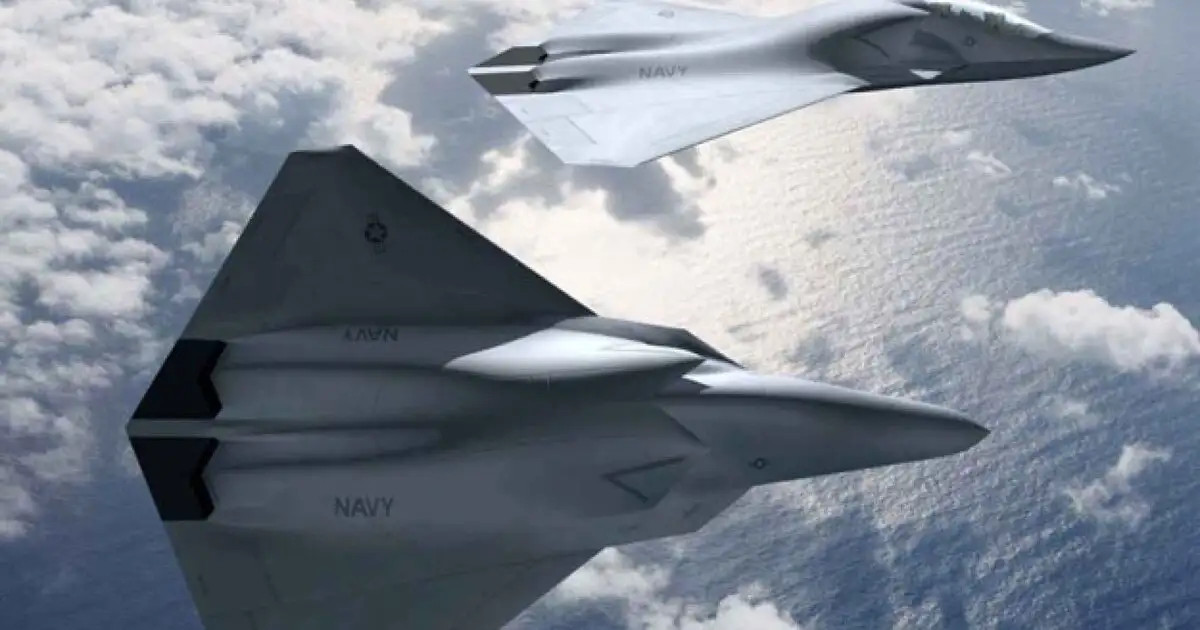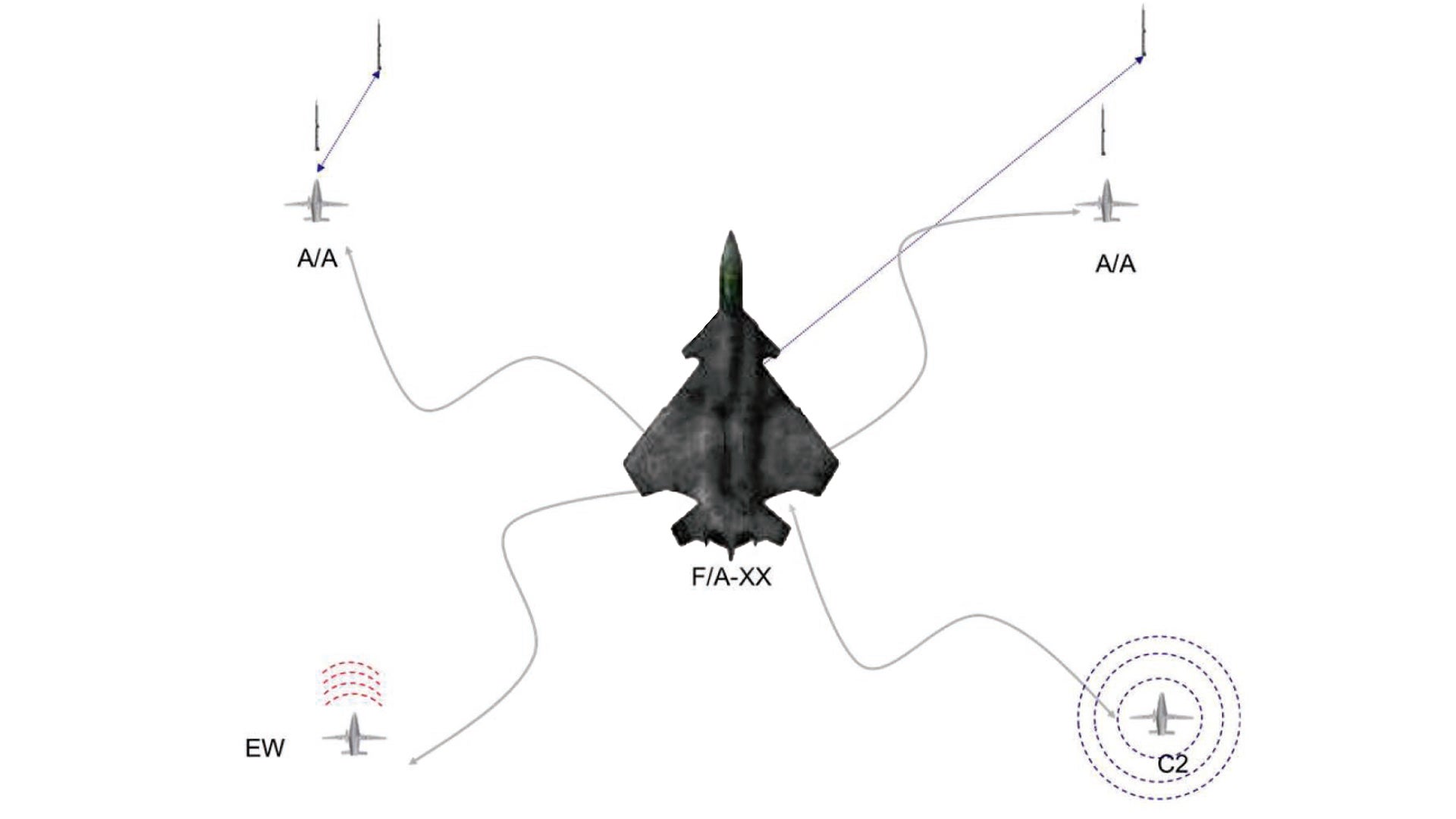The U.S. Navy has provided new details about its vision for a future F/A-XX next-generation strike fighter to replace the F/A-18E/F Super Hornet in the 2030s, as well as new art depicting a notional design. The service says it wants these aircraft to fly farther and faster than the existing Super Hornet, have improved sensor capabilities, and be able to employ future longer-range weapons. It also expects the F/A-XX to act as a “quarterback” for groups of unmanned aircraft carrying munitions, equipped with electronic warfare suites, configured as command and control nodes, and more.
The new details and artwork related to the F/A-XX program, among other things, were contained within an unclassified document titled “Navy Aviation Vision, 2030–2035,” which the service released this week. F/A-XX dates back to at least 2012, and it is now part of the Navy’s larger Next Generation Air Dominance (NGAD) effort.
The new F/A-XX artwork, which only shows a top-down view, depicts a design with a broad, almost lambda-wing shape and canard foreplanes. As Aviation Week‘s defense editor Steve Trimble was quick to point out on Twitter, this notional aircraft may have “ruddervator” tailplanes, similar in broad strokes to the ones found on Northrop’s YF-23 stealth fighter, but that the art is so low resolution that it could also easily have more traditional twin tails.
Regardless, there is no indication that this reflects a design that is actually being actively developed, and it is much more likely to be a simple placeholder. It has numerous features that would call into question its stealthy characteristics. Beyond that, it generally seems unlikely the Navy would disclose an actual advanced aircraft design now in development in this kind of unclassified document. Still, it is interesting how markedly different it is from other previous F/A-XX concept art, which has almost universally depicted tailless planforms.

As for the jet’s desired capabilities, the Navy says it is still in the process of determining exactly what it wants, but the service did lay out the following general parameters:
The F/A-XX is the strike fighter component within the Next Generation Air Dominance (NGAD) Family of Systems (FoS). It is planned to replace the F/A-18E/F Super Hornet in the 2030s. Its specific capabilities and technologies are under development, however analysis shows it must have longer range and greater speed, incorporate passive and active sensor technology, and possess the capability to employ the longer-range weapons programmed for the future. As the Super Hornets are retired from service, a combination of F-35C and F/A-XX will provide Navy tactical fighter aircraft capability and capacity within the CVW [carrier air wing]. The advanced carrier-based power projection capabilities resident in F/AXX will maintain CVN [aircraft carrier] relevance in advanced threat environments.
Most of this makes perfect sense, especially the desire for greater range and speed, which would enable carriers to launch future F/A-XX aircraft at greater distances from their objectives without necessarily increasing the time it takes those jets to arrive on scene. Longer range weapons, including future hypersonic missiles, would only further extend the stand-off reach of these planes.
All of this would, in turn, help reduce the vulnerability of the F/A-XX, as well as allow carriers to remain farther away from increasingly more threatening enemy defenses, including anti-ship cruise and ballistic missiles. There is likely to be even more interest in greater range now that still largely unknown issues have led to a halt in plans to add conformal fuel tanks to new and upgraded Super Hornets in the Block III configuration, at least for the time being.

The Navy’s new aviation vision document also makes clear that the goal is for F/A-XX to be at the center of manned-unmanned teaming capabilities within the service’s future carrier air wings:
Along with organic tanking, the MQ-25 will pave the way for unmanned air vehicles on the carrier and manned and unmanned teaming (MUM-T) to extend strike range and enhance maneuverability. As unmanned tanking capacity delivers, the manned tanker requirement decreases, making additional service life and capacity available for strike fighter missions. Continued development of MUM-T will enable information sharing across a distributed force, increasing survivability, reducing risk to manned aircraft, and ensuring weapons capacity. Future unmanned air vehicles with survivable planforms, sensors, and robust autonomy will find, fix, identify, track, engage, and assess land, sea, and air targets. The NGAD FoS will include unmanned platforms with F/A-XX as the quarterback. These manned and unmanned aircraft plus attritable assets will be employed across domains to enable integrated kinetic and non-kinetic fires at tactically relevant ranges. As autonomy and ML [machine learning] efforts mature, the appropriate mix of F/A-XX, manned and unmanned platforms will be evaluated to ensure the most lethal and affordable CVW possible.
The separation of “manned and unmanned” from “attritable assets” is interesting given that the latter category has typically been described across the U.S. military as applying exclusively to unmanned systems. Attritable can be hard to define, but it is often described as a low-cost platform designed with a specific and generally relatively short service life in mind, and that is therefore cheap enough to be suitable for higher risk missions where commanders might be more reticent to employ more advanced and costlier designs. There are indications that the Air Force may now be refocusing its understanding of attritable to be more centered on cost, as you can read about here. Affordability is something the Navy has also highlighted here in its discussion about the optimum mix of manned and unmanned aircraft in its future carrier air wings.
When it comes to exactly what the F/A-XX will “quarterback,” a graphic included in the aviation vision, seen at the top of this story, shows two air-to-air (“A/A”) drones, armed with air-to-air missiles, as well as one with an electronic warfare (“EW”) package and another command-and-control (“C2”) configured type. Though no further information is provided, the C2 drone is likely understood as one fitted with an advanced communications gateway capable of linking together stealthy aircraft, as F/A-XX is expected to be, and non-stealth ones, as well as various other nodes, including those on the ground and at sea.
Otherwise, the Navy’s description of the unmanned platforms it envisions F/A-XXs controlling aligns well with various programs that are publicly known to be ongoing now across the U.S. military. This includes projects focused on developing advanced semi-autonomous “loyal wingman” type drones that would work directly with manned aircraft, as well as ones exploring fully autonomous networked swarms of both unmanned aircraft and munitions. Many of these efforts are heavily linked to work on artificial intelligence and machine learning to provide greater autonomy, as well.
The Navy, specifically, has been directly involved in the development of loyal wingmen and artificial intelligence-driven systems to fly them, as well as the MQ-25 tanker drone, which is already being eyed for other roles. The service is also pursuing an entire revolutionary new electronic warfare ecosystem, dubbed the Netted Emulation of Multi-Element Signature against Integrated Sensors, or NEMESIS.

The core idea behind NEMESIS, which you can read about more in this past War Zone feature, is to network together electronic warfare capabilities, including on both manned and unmanned platforms, including swarms, ships, and submarines. A key focus of the project is to be able to use that combined capacity to create phantom fleets of aircraft and ships that appear to various enemy sensors, located over great areas, at once. This would theoretically upend an enemy’s decision-making cycle and cause great confusion as to what is actually going on, sucking up critical time and resources and misdirecting their actions. Beyond these coordinated objectives, systems connected under NEMESIS, or a concept like it, would otherwise collaborate to conduct more effective and efficient electronic warfare operations against a highly capable adversary.
Overall, as the Navy’s new aviation vision makes clear, the service is still very much in the process of defining exactly what it wants from F/A-XX. At the same time, the core requirements are clearly coming together already and the plans for this next-generation strike fighter will need to get firmer relatively soon if the goal is still to begin replacing Super Hornets with these new aircraft starting in the 2030s. Beyond that, this is pretty much exactly what we have been describing as necessary for years now. So it is good to see some movement towards these concepts, especially when it comes to the widespread introduction of advanced unmanned platforms into the naval air warfare equation, as well as manned carrier-capable platforms with much longer range.
Also as we have expressed repeatedly, this system of systems, in which manned platforms with greater range, lower observability (stealthiness), and possibly greater speed, are paired with a family of unmanned combat air vehicles and networked weaponry also likely mirrors what the U.S. Air Force is executing with its own NGAD initiative. In the case of that service, a prototype system is already flying.
It’s very possible that the Navy will pursue a similar risk-reduction effort now that its NGAD initiative is picking up steam — if it hasn’t started already.
Contact the author: joe@thedrive.com

